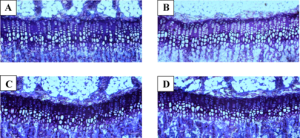A lot of interesting stuff here:
In vivo dynamic loading reduces bone growth without histomorphometric changes of the growth plate
“This in vivo study aimed at investigating the effects of dynamic compression on the growth plate. Rats (28 days old) were divided into three dynamically loaded groups, compared with two groups (control, sham). A device was implanted on the 6th and 8th caudal vertebrae for 15 days. Controls (n = 4) did not undergo surgery. Shams (n = 4) were operated but not loaded. Dynamic groups had sinusoidal compression with a mean value of 0.2 MPa: 1.0 Hz and ±0.06 MPa (group a, n = 4); 0.1 Hz and ±0.2 MPa (group b, n = 4); 1.0 Hz and ±0.14 MPa (group c, n = 3). Growth rates (µm/day) of dynamic groups (a) and (b) were lower than shams. Growth plate heights, hypertrophic cell heights and proliferative cell counts per column did not change in dynamic (a) and (b) groups compared with shams. Rats from dynamic group (c) had repeated inflammations damaging tissues; consequently, their analysis was unachievable. Increasing magnitude or frequency leads to growth reduction without histomorphometric changes. However, the combined augmentation of magnitude and frequency alter drastically growth plate integrity. Appropriate loading parameters could be leveraged for developing novel growth modulation implants to treat skeletal deformities.”
“Three main factors contributing to bone growth are cellular enlargement in the hypertrophic zone (40–50%), matrix synthesis (35–45%) and cell duplication in the proliferative zone (10%).”
“different frequencies and magnitudes of the dynamic loading applied for 10 min per day in rats forelimbs, and found that growth was reduced proportionally to load magnitude and not the average load.”<-Magnitude is the peak load. So the peak load you obtain with say LSJL has the largest impact on the stimulus. Note that the loads advocated here are compressive loads rather than the more tensile load of LSJL.
“among dynamic parameters, we suggest that frequency has more impact on growth compared to magnitude.”<-It’s a lot harder to modulate frequency than magnitude with LSJL.
Dynamic Compressive Loading decreased growth in the Cd7 vertebrae. Produced a minor growth rate reduction on Cd5. However, it increased growth rate on CD9 so the various disc growth plates may respond to mechanical stimuli differently.
 A and B are control group. C and D are the compressed group. You can definitely see the compression of cells.
A and B are control group. C and D are the compressed group. You can definitely see the compression of cells.
